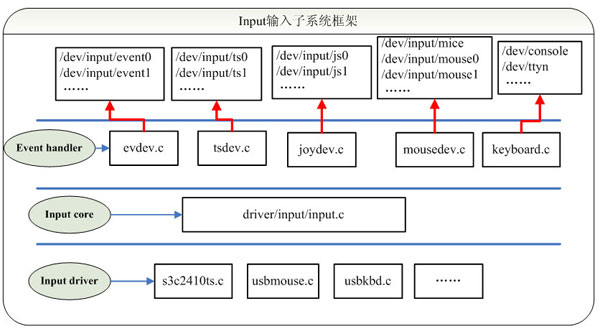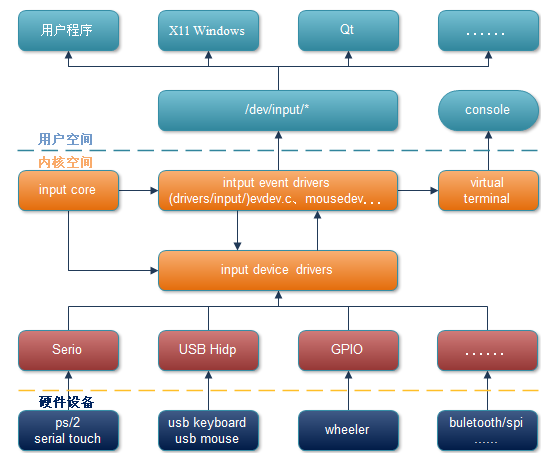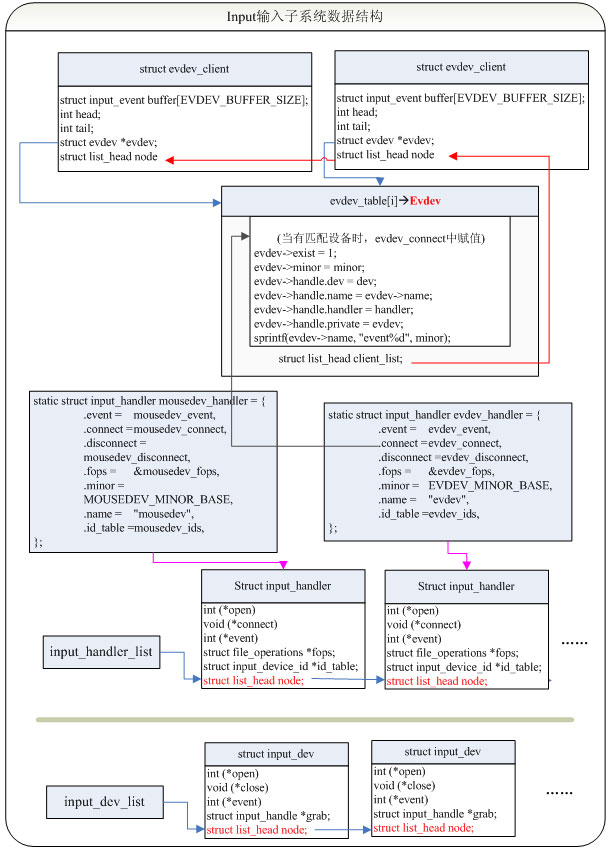Linux输入子系统详解
input输入子系统框架
linux输入子系统(linux input subsystem)从上到下由三层实现,分别为:输入子系统事件处理层(EventHandler)、输入子系统核心层(InputCore)和输入子系统设备驱动层。
一个输入事件,如鼠标移动,键盘按键按下,joystick的移动等等通过 input driver -> Input core -> Event handler -> userspace 到达用户空间传给应用程序。

【注意】keyboard.c不会在/dev/input下产生节点,而是作为ttyn终端(不包括串口终端)的输入。
驱动层
对于输入子系统设备驱动层而言,主要实现对硬件设备的读写访问,中断设置,并把硬件产生的事件转换为核心层定义的规范提交给事件处理层。将底层的硬件输入转化为统一事件形式,想输入核心(Input Core)汇报。
输入子系统核心层
对于核心层而言,为设备驱动层提供了规范和接口。设备驱动层只要关心如何驱动硬件并获得硬件数据(例如按下的按键数据),然后调用核心层提供的接口,核心层会自动把数据提交给事件处理层。它承上启下为驱动层提供输入设备注册与操作接口,如:input_register_device;通知事件处理层对事件进行处理;在/Proc下产生相应的设备信息。
事件处理层
对于事件处理层而言,则是用户编程的接口(设备节点),并处理驱动层提交的数据处理。主要是和用户空间交互(Linux中在用户空间将所有的设备都当作文件来处理,由于在一般的驱动程序中都有提供fops接口,以及在/dev下生成相应的设备文件nod,这些操作在输入子系统中由事件处理层完成)。
/dev/input目录下显示的是已经注册在内核中的设备编程接口,用户通过open这些设备文件来打开不同的输入设备进行硬件操作。
事件处理层为不同硬件类型提供了用户访问及处理接口。例如当我们打开设备/dev/input/mice时,会调用到事件处理层的Mouse Handler来处理输入事件,这也使得设备驱动层无需关心设备文件的操作,因为Mouse Handler已经有了对应事件处理的方法。
输入子系统由内核代码drivers/input/input.c构成,它的存在屏蔽了用户到设备驱动的交互细节,为设备驱动层和事件处理层提供了相互通信的统一界面。

由上图可知输入子系统核心层提供的支持以及如何上报事件到input event drivers。
作为输入设备的驱动开发者,需要做以下几步:
- 在驱动加载模块中,设置你的input设备支持的事件类型
- 注册中断处理函数,例如键盘设备需要编写按键的抬起、放下,触摸屏设备需要编写按下、抬起、绝对移动,鼠标设备需要编写单击、抬起、相对移动,并且需要在必要的时候提交硬件数据(键值/坐标/状态等等)
- 将输入设备注册到输入子系统中
///////////////////////////////////////////////////////////////////分割线/////////////////////////////////////////////////////////////////////////////////
输入核心提供了底层输入设备驱动程序所需的API,如分配/释放一个输入设备:
struct input_dev *input_allocate_device(void);
void input_free_device(struct input_dev *dev);
/**
* input_allocate_device - allocate memory for new input device
*
* Returns prepared struct input_dev or NULL.
*
* NOTE: Use input_free_device() to free devices that have not been
* registered; input_unregister_device() should be used for already
* registered devices.
*/
struct input_dev *input_allocate_device(void)
{
struct input_dev *dev;
/*分配一个input_dev结构体,并初始化为0*/
dev = kzalloc(sizeof(struct input_dev), GFP_KERNEL);
if (dev) {
dev->dev.type = &input_dev_type;/*初始化设备的类型*/
dev->dev.class = &input_class; /*设置为输入设备类*/
device_initialize(&dev->dev);/*初始化device结构*/
mutex_init(&dev->mutex); /*初始化互斥锁*/
spin_lock_init(&dev->event_lock); /*初始化事件自旋锁*/
INIT_LIST_HEAD(&dev->h_list);/*初始化链表*/
INIT_LIST_HEAD(&dev->node); /*初始化链表*/ __module_get(THIS_MODULE);/*模块引用技术加1*/
} return dev;
}
注册/注销输入设备用的接口如下:
int __must_check input_register_device(struct input_dev *);
void input_unregister_device(struct input_dev *);
/**
* input_register_device - register device with input core
* @dev: device to be registered
*
* This function registers device with input core. The device must be
* allocated with input_allocate_device() and all it's capabilities
* set up before registering.
* If function fails the device must be freed with input_free_device().
* Once device has been successfully registered it can be unregistered
* with input_unregister_device(); input_free_device() should not be
* called in this case.
*/
int input_register_device(struct input_dev *dev)
{
//定义一些函数中将用到的局部变量
static atomic_t input_no = ATOMIC_INIT();
struct input_handler *handler;
const char *path;
int error;
//设置 input_dev 所支持的事件类型,由 evbit 成员来表示。具体类型在后面归纳。
/* Every input device generates EV_SYN/SYN_REPORT events. */
__set_bit(EV_SYN, dev->evbit); /* KEY_RESERVED is not supposed to be transmitted to userspace. */
__clear_bit(KEY_RESERVED, dev->keybit); /* Make sure that bitmasks not mentioned in dev->evbit are clean. */
input_cleanse_bitmasks(dev); //初始化 timer 定时器,用来处理重复点击按键。(去抖)
/*
* If delay and period are pre-set by the driver, then autorepeating
* is handled by the driver itself and we don't do it in input.c.
*/
init_timer(&dev->timer);
//如果 rep[REP_DELAY] 和 [REP_PERIOD] 没有设值,则赋默认值。为了去抖。
if (!dev->rep[REP_DELAY] && !dev->rep[REP_PERIOD]) {
dev->timer.data = (long) dev;
dev->timer.function = input_repeat_key;
dev->rep[REP_DELAY] = ;
dev->rep[REP_PERIOD] = ;
}
//检查下列两个函数是否被定义,没有被定义则赋默认值。
if (!dev->getkeycode)
dev->getkeycode = input_default_getkeycode;//得到指定位置键值 if (!dev->setkeycode)
dev->setkeycode = input_default_setkeycode;//设置指定位置键值
//设置 input_dev 中 device 的名字为 inputN
//将如 input0 input1 input2 出现在 sysfs 文件系统中
dev_set_name(&dev->dev, "input%ld",
(unsigned long) atomic_inc_return(&input_no) - );
//将 input->dev 包含的 device 结构注册到 Linux 设备模型中。
error = device_add(&dev->dev);
if (error)
return error;
//打印设备的路径并输出调试信息
path = kobject_get_path(&dev->dev.kobj, GFP_KERNEL);
printk(KERN_INFO "input: %s as %s\n",
dev->name ? dev->name : "Unspecified device", path ? path : "N/A");
kfree(path); error = mutex_lock_interruptible(&input_mutex);
if (error) {
device_del(&dev->dev);
return error;
}
//将 input_dev 加入 input_dev_list 链表中(这个链表中包含有所有 input 设备)
list_add_tail(&dev->node, &input_dev_list); list_for_each_entry(handler, &input_handler_list, node)
//调用 input_attatch_handler()函数匹配 handler 和 input_dev。
//这个函数很重要,在后面单独分析。
input_attach_handler(dev, handler); input_wakeup_procfs_readers(); mutex_unlock(&input_mutex); return ;
}
而对于所有的输入事件,内核都用统一的数据结构来描述,这个数据结构是input_event
/*
* The event structure itself
*/ struct input_event {
struct timeval time; //<输入事件发生的时间
__u16 type; //<输入事件的类型
__u16 code; //<在输入事件类型下的编码
__s32 value; //<code的值
};
输入事件的类型--input_event.type
/*
* Event types
*/ #define EV_SYN 0x00 //< 同步事件
#define EV_KEY 0x01 //< 按键事件
#define EV_REL 0x02 //<相对坐标(如:鼠标移动,报告相对最后一次位置的偏移)
#define EV_ABS 0x03 //< 绝对坐标(如:触摸屏或操作杆,报告绝对的坐标位置)
#define EV_MSC 0x04 //< 其它
#define EV_SW 0x05 //<开关
#define EV_LED 0x11 //<按键/设备灯
#define EV_SND 0x12 //<声音/警报
#define EV_REP 0x14 //<重复
#define EV_FF 0x15 //<力反馈
#define EV_PWR 0x16 //<电源
#define EV_FF_STATUS 0x17 //<力反馈状态
#define EV_MAX 0x1f //< 事件类型最大个数和提供位掩码支持
#define EV_CNT (EV_MAX+1)
Linux输入子系统提供了设备驱动层上报输入事件的函数
报告输入事件用的接口如下:
/* 报告指定type、code的输入事件 */
void input_event(struct input_dev *dev, unsigned int type, unsigned int code, int value);
/* 报告键值 */
static inline void input_report_key(struct input_dev *dev, unsigned int code, int value)
{
input_event(dev, EV_KEY, code, !!value);
}
/* 报告相对坐标 */
static inline void input_report_rel(struct input_dev *dev, unsigned int code, int value)
{
input_event(dev, EV_REL, code, value);
}
/* 报告绝对坐标 */
static inline void input_report_abs(struct input_dev *dev, unsigned int code, int value)
{
input_event(dev, EV_ABS, code, value);
}
...
当提交输入设备产生的输入事件之后,需要调用下面的函数来通知输入子系统,以处理设备产生的完整事件:
void input_sync(struct input_dev *dev);
【例子】驱动实现——报告结束input_sync()同步用于告诉input core子系统报告结束,触摸屏设备驱动中,一次点击的整个报告过程如下:
input_reprot_abs(input_dev,ABS_X,x); //x坐标 input_reprot_abs(input_dev,ABS_Y,y); // y坐标 input_reprot_abs(input_dev,ABS_PRESSURE,); input_sync(input_dev);//同步结束
【例子】按键中断程序
//按键初始化
static int __init button_init(void)
{//申请中断
if(request_irq(BUTTON_IRQ,button_interrupt,,”button”,NUll))
return –EBUSY;
set_bit(EV_KEY,button_dev.evbit); //支持EV_KEY事件
set_bit(BTN_0,button_dev.keybit); //支持设备两个键
set_bit(BTN_1,button_dev.keybit); //
input_register_device(&button_dev);//注册input设备
}
/*在按键中断中报告事件*/
Static void button_interrupt(int irq,void *dummy,struct pt_regs *fp)
{
input_report_key(&button_dev,BTN_0,inb(BUTTON_PORT0));//读取寄存器BUTTON_PORT0的值
input_report_key(&button_dev,BTN_1,inb(BUTTON_PORT1));
input_sync(&button_dev);
}
【小结】input子系统仍然是字符设备驱动程序,但是代码量减少很多,input子系统只需要完成两个工作:初始化和事件报告(这里在linux中是通过中断来实现的)。
Event Handler层解析
Input输入子系统数据结构关系图

input_handler结构体
struct input_handle; /**
* struct input_handler - implements one of interfaces for input devices
* @private: driver-specific data
* @event: event handler. This method is being called by input core with
* interrupts disabled and dev->event_lock spinlock held and so
* it may not sleep
* @filter: similar to @event; separates normal event handlers from
* "filters".
* @match: called after comparing device's id with handler's id_table
* to perform fine-grained matching between device and handler
* @connect: called when attaching a handler to an input device
* @disconnect: disconnects a handler from input device
* @start: starts handler for given handle. This function is called by
* input core right after connect() method and also when a process
* that "grabbed" a device releases it
* @fops: file operations this driver implements
* @minor: beginning of range of 32 minors for devices this driver
* can provide
* @name: name of the handler, to be shown in /proc/bus/input/handlers
* @id_table: pointer to a table of input_device_ids this driver can
* handle
* @h_list: list of input handles associated with the handler
* @node: for placing the driver onto input_handler_list
*
* Input handlers attach to input devices and create input handles. There
* are likely several handlers attached to any given input device at the
* same time. All of them will get their copy of input event generated by
* the device.
*
* The very same structure is used to implement input filters. Input core
* allows filters to run first and will not pass event to regular handlers
* if any of the filters indicate that the event should be filtered (by
* returning %true from their filter() method).
*
* Note that input core serializes calls to connect() and disconnect()
* methods.
*/
struct input_handler { void *private; void (*event)(struct input_handle *handle, unsigned int type, unsigned int code, int value);
bool (*filter)(struct input_handle *handle, unsigned int type, unsigned int code, int value);
bool (*match)(struct input_handler *handler, struct input_dev *dev);
int (*connect)(struct input_handler *handler, struct input_dev *dev, const struct input_device_id *id);
void (*disconnect)(struct input_handle *handle);
void (*start)(struct input_handle *handle); const struct file_operations *fops;
int minor;
const char *name; const struct input_device_id *id_table; struct list_head h_list;
struct list_head node;
};
【例子】以evdev.c中的evdev_handler为例:
static struct input_handler evdev_handler = {
.event = evdev_event, //<向系统报告input事件,系统通过read方法读取
.connect = evdev_connect, //<和input_dev匹配后调用connect构建
.disconnect = evdev_disconnect,
.fops = &evdev_fops, //<event设备文件的操作方法
.minor = EVDEV_MINOR_BASE, //<次设备号基准值
.name = "evdev",
.id_table = evdev_ids, //<匹配规则
};
输入设备驱动的简单案例
documentation/input/input-programming.txt文件,讲解了编写输入设备驱动程序的核心步骤。
Programming input drivers
~~~~~~~~~~~~~~~~~~~~~~~~~ . Creating an input device driver
~~~~~~~~~~~~~~~~~~~~~~~~~~~~~~~~~~ 1.0 The simplest example
~~~~~~~~~~~~~~~~~~~~~~~~ Here comes a very simple example of an input device driver. The device has
just one button and the button is accessible at i/o port BUTTON_PORT. When
pressed or released a BUTTON_IRQ happens. The driver could look like: #include <linux/input.h>
#include <linux/module.h>
#include <linux/init.h> #include <asm/irq.h>
#include <asm/io.h> static struct input_dev *button_dev; static irqreturn_t button_interrupt(int irq, void *dummy)
{
input_report_key(button_dev, BTN_0, inb(BUTTON_PORT) & );
input_sync(button_dev);
return IRQ_HANDLED;
} static int __init button_init(void)
{
int error; if (request_irq(BUTTON_IRQ, button_interrupt, , "button", NULL)) {
printk(KERN_ERR "button.c: Can't allocate irq %d\n", button_irq);
return -EBUSY;
} button_dev = input_allocate_device();
if (!button_dev) {
printk(KERN_ERR "button.c: Not enough memory\n");
error = -ENOMEM;
goto err_free_irq;
} button_dev->evbit[] = BIT_MASK(EV_KEY);
button_dev->keybit[BIT_WORD(BTN_0)] = BIT_MASK(BTN_0); error = input_register_device(button_dev);
if (error) {
printk(KERN_ERR "button.c: Failed to register device\n");
goto err_free_dev;
} return ; err_free_dev:
input_free_device(button_dev);
err_free_irq:
free_irq(BUTTON_IRQ, button_interrupt);
return error;
} static void __exit button_exit(void)
{
input_unregister_device(button_dev);
free_irq(BUTTON_IRQ, button_interrupt);
} module_init(button_init);
module_exit(button_exit); 1.1 What the example does
~~~~~~~~~~~~~~~~~~~~~~~~~ First it has to include the <linux/input.h> file, which interfaces to the
input subsystem. This provides all the definitions needed. In the _init function, which is called either upon module load or when
booting the kernel, it grabs the required resources (it should also check
for the presence of the device). Then it allocates a new input device structure with input_allocate_device()
and sets up input bitfields. This way the device driver tells the other
parts of the input systems what it is - what events can be generated or
accepted by this input device. Our example device can only generate EV_KEY
type events, and from those only BTN_0 event code. Thus we only set these
two bits. We could have used set_bit(EV_KEY, button_dev.evbit);
set_bit(BTN_0, button_dev.keybit); as well, but with more than single bits the first approach tends to be
shorter. Then the example driver registers the input device structure by calling input_register_device(&button_dev); This adds the button_dev structure to linked lists of the input driver and
calls device handler modules _connect functions to tell them a new input
device has appeared. input_register_device() may sleep and therefore must
not be called from an interrupt or with a spinlock held. While in use, the only used function of the driver is button_interrupt() which upon every interrupt from the button checks its state and reports it
via the input_report_key() call to the input system. There is no need to check whether the interrupt
routine isn't reporting two same value events (press, press for example) to
the input system, because the input_report_* functions check that
themselves. Then there is the input_sync() call to tell those who receive the events that we've sent a complete report.
This doesn't seem important in the one button case, but is quite important
for for example mouse movement, where you don't want the X and Y values
to be interpreted separately, because that'd result in a different movement. 1.2 dev->open() and dev->close()
~~~~~~~~~~~~~~~~~~~~~~~~~~~~~~~~ In case the driver has to repeatedly poll the device, because it doesn't
have an interrupt coming from it and the polling is too expensive to be done
all the time, or if the device uses a valuable resource (eg. interrupt), it
can use the open and close callback to know when it can stop polling or
release the interrupt and when it must resume polling or grab the interrupt
again. To do that, we would add this to our example driver: static int button_open(struct input_dev *dev)
{
if (request_irq(BUTTON_IRQ, button_interrupt, , "button", NULL)) {
printk(KERN_ERR "button.c: Can't allocate irq %d\n", button_irq);
return -EBUSY;
} return ;
} static void button_close(struct input_dev *dev)
{
free_irq(IRQ_AMIGA_VERTB, button_interrupt);
} static int __init button_init(void)
{
...
button_dev->open = button_open;
button_dev->close = button_close;
...
} Note that input core keeps track of number of users for the device and
makes sure that dev->open() is called only when the first user connects
to the device and that dev->close() is called when the very last user
disconnects. Calls to both callbacks are serialized. The open() callback should return a in case of success or any nonzero value
in case of failure. The close() callback (which is void) must always succeed. 1.3 Basic event types
~~~~~~~~~~~~~~~~~~~~~ The most simple event type is EV_KEY, which is used for keys and buttons.
It's reported to the input system via: input_report_key(struct input_dev *dev, int code, int value) See linux/input.h for the allowable values of code (from to KEY_MAX).
Value is interpreted as a truth value, ie any nonzero value means key
pressed, zero value means key released. The input code generates events only
in case the value is different from before. In addition to EV_KEY, there are two more basic event types: EV_REL and
EV_ABS. They are used for relative and absolute values supplied by the
device. A relative value may be for example a mouse movement in the X axis.
The mouse reports it as a relative difference from the last position,
because it doesn't have any absolute coordinate system to work in. Absolute
events are namely for joysticks and digitizers - devices that do work in an
absolute coordinate systems. Having the device report EV_REL buttons is as simple as with EV_KEY, simply
set the corresponding bits and call the input_report_rel(struct input_dev *dev, int code, int value) function. Events are generated only for nonzero value. However EV_ABS requires a little special care. Before calling
input_register_device, you have to fill additional fields in the input_dev
struct for each absolute axis your device has. If our button device had also
the ABS_X axis: button_dev.absmin[ABS_X] = ;
button_dev.absmax[ABS_X] = ;
button_dev.absfuzz[ABS_X] = ;
button_dev.absflat[ABS_X] = ; Or, you can just say: input_set_abs_params(button_dev, ABS_X, , , , ); This setting would be appropriate for a joystick X axis, with the minimum of
, maximum of (which the joystick *must* be able to reach, no problem if
it sometimes reports more, but it must be able to always reach the min and
max values), with noise in the data up to +- , and with a center flat
position of size . If you don't need absfuzz and absflat, you can set them to zero, which mean
that the thing is precise and always returns to exactly the center position
(if it has any). 1.4 BITS_TO_LONGS(), BIT_WORD(), BIT_MASK()
~~~~~~~~~~~~~~~~~~~~~~~~~~ These three macros from bitops.h help some bitfield computations: BITS_TO_LONGS(x) - returns the length of a bitfield array in longs for
x bits
BIT_WORD(x) - returns the index in the array in longs for bit x
BIT_MASK(x) - returns the index in a long for bit x 1.5 The id* and name fields
~~~~~~~~~~~~~~~~~~~~~~~~~~~~~~~~~~~ The dev->name should be set before registering the input device by the input
device driver. It's a string like 'Generic button device' containing a
user friendly name of the device. The id* fields contain the bus ID (PCI, USB, ...), vendor ID and device ID
of the device. The bus IDs are defined in input.h. The vendor and device ids
are defined in pci_ids.h, usb_ids.h and similar include files. These fields
should be set by the input device driver before registering it. The idtype field can be used for specific information for the input device
driver. The id and name fields can be passed to userland via the evdev interface. 1.6 The keycode, keycodemax, keycodesize fields
~~~~~~~~~~~~~~~~~~~~~~~~~~~~~~~~~~~~~~~~~~~~~~~~ These three fields should be used by input devices that have dense keymaps.
The keycode is an array used to map from scancodes to input system keycodes.
The keycode max should contain the size of the array and keycodesize the
size of each entry in it (in bytes). Userspace can query and alter current scancode to keycode mappings using
EVIOCGKEYCODE and EVIOCSKEYCODE ioctls on corresponding evdev interface.
When a device has all aforementioned fields filled in, the driver may
rely on kernel's default implementation of setting and querying keycode
mappings. 1.7 dev->getkeycode() and dev->setkeycode()
~~~~~~~~~~~~~~~~~~~~~~~~~~~~~~~~~~~~~~~~~~~~~~~~
getkeycode() and setkeycode() callbacks allow drivers to override default
keycode/keycodesize/keycodemax mapping mechanism provided by input core
and implement sparse keycode maps. 1.8 Key autorepeat
~~~~~~~~~~~~~~~~~~ ... is simple. It is handled by the input.c module. Hardware autorepeat is
not used, because it's not present in many devices and even where it is
present, it is broken sometimes (at keyboards: Toshiba notebooks). To enable
autorepeat for your device, just set EV_REP in dev->evbit. All will be
handled by the input system. 1.9 Other event types, handling output events
~~~~~~~~~~~~~~~~~~~~~~~~~~~~~~~~~~~~~~~~~~~~~ The other event types up to now are: EV_LED - used for the keyboard LEDs.
EV_SND - used for keyboard beeps. They are very similar to for example key events, but they go in the other
direction - from the system to the input device driver. If your input device
driver can handle these events, it has to set the respective bits in evbit,
*and* also the callback routine: button_dev->event = button_event; int button_event(struct input_dev *dev, unsigned int type, unsigned int code, int value);
{
if (type == EV_SND && code == SND_BELL) {
outb(value, BUTTON_BELL);
return ;
}
return -;
} This callback routine can be called from an interrupt or a BH (although that
isn't a rule), and thus must not sleep, and must not take too long to finish.
input-programming.txt
该例子提供的案例代码描述了一个button设备,产生的事件通过BUTTON_PORT引脚获取,当有按下/释放发生时,BUTTON_IRQ被触发,以下是驱动的源代码:
#include <linux/input.h>
#include <linux/module.h>
#include <linux/init.h> #include <asm/irq.h>
#include <asm/io.h> static struct input_dev *button_dev; /*输入设备结构体*/
/*中断处理函数*/
static irqreturn_t button_interrupt(int irq, void *dummy)
{
/*向输入子系统报告产生按键事件*/
input_report_key(button_dev, BTN_0, inb(BUTTON_PORT) & );
/*通知接收者,一个报告发送完毕*/
input_sync(button_dev);
return IRQ_HANDLED;
}
/*加载函数*/
static int __init button_init(void)
{
int error;
/*申请中断处理函数*/ //返回0表示成功,返回-INVAL表示无效
if (request_irq(BUTTON_IRQ, button_interrupt, , "button", NULL)) {
/*申请失败,则打印出错信息*/
printk(KERN_ERR "button.c: Can't allocate irq %d\n", button_irq);
return -EBUSY;
}
/*分配一个设备结构体*/
//将在 sys/class/input/input-n 下面创建设备属性文件
button_dev = input_allocate_device();
if (!button_dev) { /*判断分配是否成功*/
printk(KERN_ERR "button.c: Not enough memory\n");
error = -ENOMEM;
goto err_free_irq;
} button_dev->evbit[] = BIT_MASK(EV_KEY); /*设置按键信息*/
button_dev->keybit[BIT_WORD(BTN_0)] = BIT_MASK(BTN_0); error = input_register_device(button_dev); /*注册一个输入设备*/
if (error) {
printk(KERN_ERR "button.c: Failed to register device\n");
goto err_free_dev;
} return ;
/*以下是错误处理*/
err_free_dev:
input_free_device(button_dev);
err_free_irq:
free_irq(BUTTON_IRQ, button_interrupt);
return error;
}
/*卸载函数*/
static void __exit button_exit(void)
{
input_unregister_device(button_dev); /*注销按键设备*/
free_irq(BUTTON_IRQ, button_interrupt);/*释放按键占用的中断线*/
} module_init(button_init);
module_exit(button_exit);
从这个简单的例子中可以看到。
在初始化函数 button_init() 中注册了一个中断处理函数,然后调用 input_allocate_device() 函数分配了一个 input_dev 结构体,并调用 input_register_device() 对其进行注册。
在中断处理函数 button_interrupt() 中,实例将接收到的按键信息上报给 input 子系统,从而通过 input子系统,向用户态程序提供按键输入信息。
Linux输入子系统详解的更多相关文章
- linux input子系统详解
首先,什么是linux的子系统: 输入子系统由驱动层.输入子系统核心.事件处理层三部分组成.一个输入事件,如鼠标移动通过Driver->Input core->Event handler- ...
- driver: Linux设备模型之input子系统详解
本节从整体上讲解了输入子系统的框架结构.有助于读者从整体上认识linux的输入子系统.在陷入代码分析的过程中,通过本节的知识能够找准方向,明白原理. 本节重点: 输入子系统的框架结构 各层对应内核中的 ...
- 7.Linux 输入子系统分析
为什么要引入输入子系统? 在前面我们写了一些简单的字符设备的驱动程序,我们是怎么样打开一个设备并操作的呢? 一般都是在执行应用程序时,open一个特定的设备文件,如:/dev/buttons .... ...
- Linux输入子系统 转载
NQian 记录成长~ 首页 新随笔 联系 订阅 管理 随笔 - 305 文章 - 0 评论 - 254 12.Linux之输入子系统分析(详解) 在此节之前,我们学的都是简单的字符驱动,涉及 ...
- linux awk命令详解
linux awk命令详解 简介 awk是一个强大的文本分析工具,相对于grep的查找,sed的编辑,awk在其对数据分析并生成报告时,显得尤为强大.简单来说awk就是把文件逐行的读入,以空格为默认分 ...
- Linux启动过程详解(inittab、rc.sysinit、rcX.d、rc.local)
启动第一步--加载BIOS 当你打开计算机电源,计算机会首先加载BIOS信息,BIOS信息是如此的重要,以至于计算机必须在最开始就找到它.这是因为BIOS中包含了CPU的相关信息.设备启动顺序信息.硬 ...
- Linux启动过程详解
Linux启动过程详解 附上两张图,加深记忆 图1: 图2: 第一张图比较简洁明了,下面对第一张图的步骤进行详解: 加载BIOS 当你打开计算机电源,计算机会首先加载BIOS信息,BIOS信息是如此的 ...
- Linux /dev目录详解和Linux系统各个目录的作用
Linux /dev目录详解(转http://blog.csdn.net/maopig/article/details/7195048) 在linux下,/dev目录是很重要的,各种设备都在下面.下面 ...
- linux curl用法详解
linux curl用法详解 curl的应用方式,一是可以直接通过命令行工具,另一种是利用libcurl库做上层的开发.本篇主要总结一下命令行工具的http相关的应用, 尤其是http下载方面 ...
随机推荐
- Alpha冲刺10
前言 队名:拖鞋旅游队 组长博客:https://www.cnblogs.com/Sulumer/p/10045588.html 作业博客:https://edu.cnblogs.com/campus ...
- ngnix——FastCGI 相关参数调优
当 LNMP 组合工作时,首先是用户通过浏览器输入域名请求 Nginx Web 服务,如果请求的是静态资源,则由 Nginx 解析返回给用户:如果是动态请求(如 PHP),那么 Nginx 就会把它通 ...
- Java通过URL 从web服务端获取数据
1.Java 通过HttpURLConnection Post方式提交json,并从服务端返回json数据 package Demo.Test; import java.io.ByteArrayOut ...
- Logging常用handlers的使用
一.StreamHandler 流handler——包含在logging模块中的三个handler之一. 能够将日志信息输出到sys.stdout, sys.stderr 或者类文件对象(更确切点,就 ...
- SpringMVC + MyBatis分库分表方案
mybatis作为流行的ORM框架,项目实际使用过程中可能会遇到分库分表的场景.mybatis在分表,甚至是同主机下的分库都可以说是完美支持的,只需要将表名或者库名作为动态参数组装sql就能够完成.但 ...
- Codeforces1062C. Banh-mi(贪心+快速幂)
题目链接:传送门 题目: C. Banh-mi time limit per test second memory limit per test megabytes input standard in ...
- Java实现带logo的二维码
Java实现带logo的二维码 二维码应用到生活的各个方面,会用代码实现二维码,我想一定是一项加分的技能.好了,我们来一起实现一下吧. 我们实现的二维码是基于QR Code的标准的,QR Code是由 ...
- C++学习(三十七)(C语言部分)之 链式栈(推箱子实现)
用链表实现栈一开始在表头插入,就要一直在表头插入一开始在表尾插入,就要一直在表头插尾表头当栈底 也可以把表尾当栈底 实现的测试代码笔记如下: #include<stdio.h> #incl ...
- EF LIKE 查询
<!-- CSDL content --> <edmx:ConceptualModels> <Schema Namespace="Model" Ali ...
- php微服务框架 PHP-MSF 的容器部署和使用
评论:1 · 阅读:8412· 喜欢:1 一.需求 PHP-msf 是 Carema360 开发的 PHP 微服务框架,目前我没有实际用过,但是市面上的微服务框架要么在推崇 Spring 系,要么是 ...
